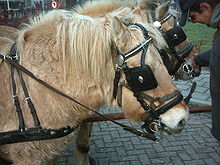Driving curbs
The driving curb , like a bridle, can be part of the bridle for horses in driving . The bridle when driving is more precisely referred to as the driving bridle . The mode of action is similar to the curb used when riding .
In contrast to the simple curb used when riding , the driving curb is not underlaid with a bridle .
A distinction is made between different basic types of driving curb according to shape and origin (selection):
- Post curbs
- Liverpool curb
- Elbow curb
- Tilbury curb
- Buxton curb
The bars of the curbs have different shapes, e.g. B. straight, "broken" or in the middle bulging rods. This so-called tongue freedom offers the horse's tongue more space, the pressure of the curb then acts more on the drawer . However, a high level of tongue freedom exerts sometimes very strong pressure on the palate when the lines are accepted. "Broken" is when the bar is connected in the middle by two interlocking eyes.
The lines are attached to the so-called "suits" of the curb. Post and Liverpool curbs have up to three eyelets on top of each other. The deeper the leash is hooked, the greater the leverage of the suit on the horse's mouth. Inexperienced riders occasionally break their jaws on the horse due to excessive tightening of the "sharp buckled" curbs.
Traditionally, certain curb shapes are used in driving for the different types of tension , z. B. Post curbs are the country tension and Liverpool bits with the city tension used.
literature
- Benno von Achenbach : Tensing and driving , Verlag Dr. Rudolf Georgi, Aachen 1922 (7th edition 1995), ISBN 3-87248-042-1
- Erich Oese: Driving two horses , Sportverlag, Berlin 1991, ISBN 3-328-00494-7
